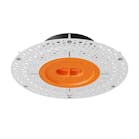Date Announced: 22 Nov 2011 Researchers from Siemens Corporate Technology and Osram have discovered a new “dark-red” luminescent material for LEDs. The phosphor, described as “stable” (although further details are not available), is an oxynitride that apparently emits at a wavelength of up to 30 nm longer (deeper red) than other materials. The material was developed by Siemens researchers using a High Throughput Experimentation (HTE) technique, which enables automated evaluation of different material combinations, rather than testing them by hand. The researchers analyzed over 660 sample variants from twelve different material combinations over a period of just a few months to determine emission wavelength, light intensity, and structural phases. +++ Press Release (Siemens) +++Researchers from Siemens Corporate Technology and Osram have discovered a new dark red luminescent material for LEDs. This was made possible by the use of a material development method known as High Throughput Experimentation (HTE), which allows the screening of large composition areas of complex material systems. The new luminescent material can be used, for example, for warm-toned white LEDs for general lighting, for backlighting of LCD screens, and for automotive applications.LEDs are the lamps of the future, since they help save energy, have a long service life, and can be flexibly used in applications. However, the selection of colors for LEDs is still limited. To convert the ultraviolet or blue light of common semiconductor chip LEDs to white light or other colors, fluorescent materials, so-called luminescent materials, must therefore be placed on the semiconductor chip. These phosphors can cover a wide range of the color spectrum even today, but there are still no efficient, stable phosphors that emit dark red light. That’s why developers are seeking new color variants. Small differences in the composition of a luminescent material have huge influence on its emission properties. Therefore it is necessary to vary the composition of the material in small steps. This leads to a lot of samples which can not be produced or analyzed by hand. The researchers of the global Siemens research organization Corporate Technology developed a special HTE technology to achieve this. It permits automated experiment planning as well as the establishment, characterization, and evaluation of so-called material libraries, which typically contain around 100 individual samples. In their HT experiments, the researchers analyzed over 660 sample variants from twelve different material combinations over a period of just a few months to determine emission wavelength, light intensity, and structural phases. The new, dark red-emitting luminescent material belongs to the large compound class of oxynitrides that permits a wavelength shift of up to 30 nanometers into the dark red range. The new luminescent material expands the patent portfolio of Osram and boosts its competitiveness. The researchers continue their search for innovative luminescent materials by screening new material systems to gain an insight into a huge number of interesting materials and give competitive advantage compared to conventional development.
Contact
Siemens
Web Site:www.siemens.com/innovation/en/news/2011/e_inno_1135_1.htm






